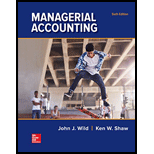
Journal: A journal is the complete record of a financial transaction which shows the debit and credit of respective accounts for every transaction including the explanation of the transaction.
T-Accounts: An account is a unique record of increases or decreases in any asset, liability, equity, revenues or expenses. T-accounts are drawn to resemble a T-shape with debit on the left and credit on the right. Assets and expenses have normally debit balances and liability, equity and revenue accounts have normally credit balance.
To analyze:
The given transaction using accounting equation.
Journal: A journal is the complete record of a financial transaction which shows the debit and credit of respective accounts for every transaction including the explanation of the transaction.
T-Accounts: An account is a unique record of increases or decreases in any asset, liability, equity, revenues or expenses. T-accounts are drawn to resemble a T-shape with debit on the left and credit on the right. Assets and expenses have normally debit balances and liability, equity and revenue accounts have normally credit balance.
To prepare:
Journal Entries for the given transaction.
Accounting Equation: Accounting equation is also known as balance sheet equation. Accounting equation is based on the principles of double entry system of accounting. The accounting equation is as follows
Journal: A journal is the complete record of a financial transaction which shows the debit and credit of respective accounts for every transaction including the explanation of the transaction.
T-Accounts: An account is a unique record of increases or decreases in any asset, liability, equity, revenues or expenses. T-accounts are drawn to resemble a T-shape with debit on the left and credit on the right. Assets and expenses have normally debit balances and liability, equity and revenue accounts have normally credit balance.
To prepare:
T-accounts for the given transactions.
Want to see the full answer?
Check out a sample textbook solution
Chapter D Solutions
Managerial Accounting
- I want to this question answer for General accounting question not need ai solutionarrow_forwardWhat is the percentage change in sales? Accounting questionarrow_forwardWayne Manufacturing estimates that overhead costs for the next year will be $4,200,000 for indirect labor and $540,000 for factory utilities. The company uses machine hours as its overhead allocation base. If 180,000 machine hours are planned for the next year, what is the company's plantwide overhead rate?arrow_forward
- A change in accounting estimate is applied? (A) Retrospectively (B) Neither prospectively nor retrospectively (C) Both prospectively and retrospectively (D) Prospectively Right answerarrow_forwardPlease provide the accurate answer to this general accounting problem using valid techniques.arrow_forwardPlease provide the solution to this general accounting question using proper accounting principles.arrow_forward
- Hello tutor please provide correct answer general accounting question with correct solution do fastarrow_forwardI am trying to find the accurate solution to this general accounting problem with appropriate explanations.arrow_forwardI need assistance with this financial accounting problem using appropriate calculation techniques.arrow_forward
 Individual Income TaxesAccountingISBN:9780357109731Author:HoffmanPublisher:CENGAGE LEARNING - CONSIGNMENT
Individual Income TaxesAccountingISBN:9780357109731Author:HoffmanPublisher:CENGAGE LEARNING - CONSIGNMENT Intermediate Accounting: Reporting And AnalysisAccountingISBN:9781337788281Author:James M. Wahlen, Jefferson P. Jones, Donald PagachPublisher:Cengage LearningPrinciples of Accounting Volume 1AccountingISBN:9781947172685Author:OpenStaxPublisher:OpenStax College
Intermediate Accounting: Reporting And AnalysisAccountingISBN:9781337788281Author:James M. Wahlen, Jefferson P. Jones, Donald PagachPublisher:Cengage LearningPrinciples of Accounting Volume 1AccountingISBN:9781947172685Author:OpenStaxPublisher:OpenStax College College Accounting (Book Only): A Career ApproachAccountingISBN:9781337280570Author:Scott, Cathy J.Publisher:South-Western College Pub
College Accounting (Book Only): A Career ApproachAccountingISBN:9781337280570Author:Scott, Cathy J.Publisher:South-Western College Pub





